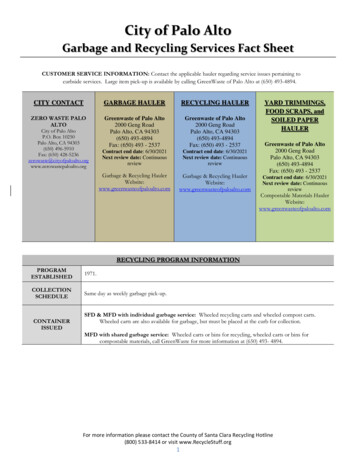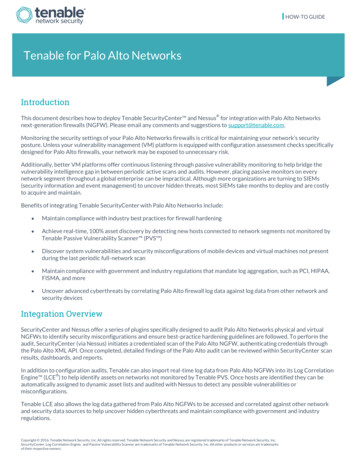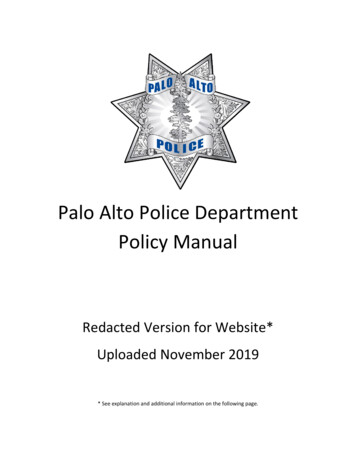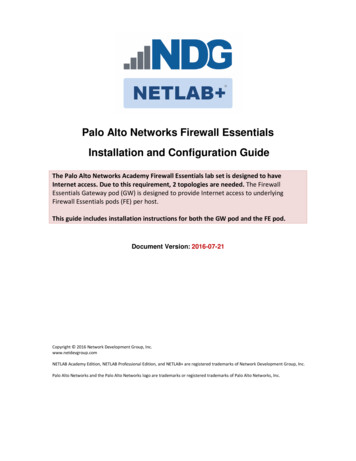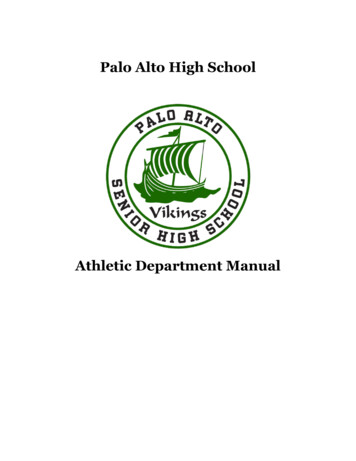
Transcription
Palo Alto High SchoolAthletic Department Manual
Athletic Department ManualTable of Contents1) Palo Alto High School Athletic Department One Ship The Purpose of Paly Athletics School Athletic Membership Central Coast SectionSanta Clara Valley Athletic LeagueSCVAL MembersAddress Department Organization Administrator of Athletics — LaDonna ButlerAthletic Director — Nelson GiffordHead Athletic Trainer — Justine Iongi Funding Athletics Paly Sports Student Association (PSSA) Sports Offered at Paly FallWinterSpring2) Student-Athlete InformationSportsmanshipAcademic EligibilityScholastic Eligibility Minimum Requirements per CIF Section 205 B.(1)Probationary Period per CIF Section 205 B.(2)Probationary Period per CIF Section 205 B.(3)Grading PeriodsGPA CalculationAcademic WaiverTryoutsAttendance & Contest Participation3) Coach InformationCoaching CertificationsVarsity Head Coach ResponsibilitiesPlayer DisciplineTryouts1
Athletic Department ManualPractice HoursAll Coaches.4) Parents & GuardiansParent ExpectationsParent RolesTeam ParentParent DriverLines of CommunicationPlayer & CoachParent & Coach5) Sports Boosters6) Athletic TrainingWho are Athletic Trainers?Vision StatementMission StatementAthletic Training Room RulesAthletic Training Room ExpectationsTraining Room ProtocolsFor AthletesAthlete Injury ReportsDoctor Notes/PhysicalsFor CoachesMiscellaneousConcussion Management ProtocolRoles of Our Concussion Management TeamTeacher or Coach’s RoleAthletic Trainer or School Nurse’s RoleParents’ RoleConcussion Evaluation PathwayEmergency Phone Numbers and Hospital Information7) Athletic Training Department Emergency Action Plan (EAP)Plan to Initiate Emergency Action PlanSystem Hierarchy Part ISystem Hierarchy Part IISee appendices for specific facility emergency action plansNatural Disasters / Severe Weather Protocol:Athletic Activity Protocol based on Air Quality Index2
Athletic Department ManualPAUSD Air Quality Index Protocol (Orange and Red)Earthquake Plan:Electrical Exposure Plan:Fire Emergency Protocol:Severe Weather Protocol:If lightning is seen:Managing a Victim of a Lightning Strike:BLOODBORNE PATHOGENS EXPOSURE CONTROL PLANCOVID-19 MONITORING, TESTING, AND REPORTINGRisk Mitigation StrategiesProper Safety Practices:Illness ReportingWellness and Hygiene - Athletic Training GuidelinesEmergency Action PlansRECOMMENDED HEALTH SCREENING FOR STUDENTS AND STAFFON CAMPUS RESPONSERETURNING TO SPORTS AFTER INFECTION:NEGATIVE TEST RESULTSROUTINE TESTINGList of PALY EAPs3
Athletic Department Manual1) Palo Alto High School Athletic Department4
Athletic Department Manual One Ship The Purpose of Paly AthleticsAt Palo Alto High School, we believe in the transformational power of education-basedathletics. Every day, our staff, coaches and student athletes — along with the greatercommunity — strive to make the Paly athletic experience safe, empowering andstudent-centered. We do this by embracing and practicing the following values; oureight sails): community, fun, honesty, respect, preparedness, accountability, strength,competitiveness.Fun — We are all born to play. We play for many reasons: to exercise our bodies,stretch our minds, to explore the edges of our potential and beyond. But most of all, weplay because it is fun. Each of us has different motivations to play, but having fun keepsus coming back. We are best at the things we love to do. So play full of joy and have fun.Respect — We all have value, and we all deserve to be treated with dignity. Respect isthe cornerstone to any relationship, and we give respect just as we expect to receive it.Showing respect costs nothing, but is worth everything.Honesty — Truth is power and freedom. Telling the truth and receiving it is not alwayseasy. However, the truth is absolutely necessary to make the best possible decisions forourselves and for others. Practice honesty every day.Preparedness — The Stoic philosopher Seneca told us that “luck is what happenswhen preparation meets opportunity.” Preparation takes no special talent or ability, butit does take consistent effort. If you stay ready, you don’t have to get ready.Accountability — Every person must be accountable for their own actions, behaviorsand attitudes. We can control other people as much as we can control the weather. Yet,we can all take responsibility for what we can control, and do everything we can in thoseareas to grow, learn and improve.Strength — Strength comes in many forms, none as powerful or limitless as ourstrength of will and character. We stand firm against obstacles that seeminsurmountable, opponents that appear unbeatable, and outcomes that we neverwanted. Our strength comes from within, built upon a foundation of community andcooperation.Competitiveness — Real competition gives us the opportunity to be the best version ofourselves. Competition is not about beating an opponent, but about creating anenvironment that moves us towards our full potential. Compete every day.Community — No matter the season or the sport, every Palo Alto High School athletewears green and white with pride. Together we are Vikings; one community with acommon vision. One Ship.5
Athletic Department Manual School Athletic Membership Central Coast Section“The Central Coast Section (CCS) is one of ten (10) sections that make up theCalifornia Interscholastic Federation (CIF). The CIF has a proud tradition inproviding equitable athletic competition for more than 1,570 high schools (bothpublic and private) in California. Since its beginning in 1914, the CIF has grownto become the largest youth agency in the nation, serving over 770,000student-athletes each year in the interscholastic athletic activities of California’ssecondary schools. The CIF is organized under the State Department ofEducation and is governed by the CIF Federated Council while operating as tensemi-autonomous, geographical Sections.” (CCS Website)6
Athletic Department ManualSanta Clara Valley Athletic LeaguePalo Alto High School is a member of the Santa Clara Valley Athletic League. The leagueis made up of 14 public schools covering four school districts. The membershipincludes: Cupertino, Fremont, Homestead, Lynbrook, Monta Vista, Gunn, Palo Alto,Saratoga, Los Gatos, Mountain View, Los Altos, Santa Clara, Wilcox and Milpitas.The SCVAL has a two-tier system for a number of its sports. The upper DeAnza Divisionand lower El Camino Division separate teams to create an equitable competitiveenvironment. Palo Alto competes in the DeAnza tier in the majority of sports. Moreinformation can be found at the SCVAL website.SCVAL MembersAddressCupertino High School10100 Finch Ave, Cupertino, CA 95014Fremont High School575 W. Fremont Ave, Sunnyvale, CA 94087Gunn High School780 Arastradero Rd, Palo Alto, CA 94306Homestead High School21370 Homestead Rd, Cupertino, CA 95014Los Altos High School201 Almond Ave, Los Altos, CA 94022Los Gatos High School20 High School Ct, Los Gatos, CA 95030Lynbrook High School1280 Johnson Ave, San Jose, CA 95129Milpitas High School1285 Escuela Pkwy, Milpitas, CA 95035Monta Vista High School21840 McClellan Rd, Cupertino, CA 95014Mountain View High School3535 Truman Ave, Mountain View, CA 94040Palo Alto High School50 Embarcadero Rd, Palo Alto, CA 94301Santa Clara High School3000 Benton st, Santa Clara, CA 95051Saratoga High School20300 Herriman Ave, Saratoga, CA 95070Wilcox High School3250 Monroe st, Santa Clara, CA 950517
Athletic Department Manual Department Organization Administrator of Athletics — LaDonna ButlerMy Belief:“Student-athletes are strategic thinkers. They strive to contribute their very best in theclassroom and athletic arena, taking on challenges as growth opportunities. Theytransfer their competitive mentality, athletic prowess and the life lessons they learnfrom participating in sports into the classroom. Student-athletes recognize that theirgreatest competitor is themselves, and therefore show up daily to develop into the mosthealthy and whole person they can be.”Bio:LaDonna Butler is a newly appointed Assistant Principal within PAUSD and will serveas the lead administrator for the Paly Athletic Community. She is a native of San Joseand has been an educator for the past 25 years. She began her career in educationsupporting low-income, first opportunity college-bound students at the NationalHispanic University, Pre-College Division. She graduated from Silver Creek HighSchool, with the honor of being the first female athlete to receive a four-year Division Ischolarship. LaDonna attended San Jose State University earning a Baccalaureate ofScience, Kinesiology. Her experiences as a student-athlete and TRiO Program AssistantDirector led her to obtain her teaching credential, enabling her to continue her passionfor bridging the gap between secondary and post-secondary opportunities for students.She taught physical education within East Side Union and San Jose Unified SchoolDistricts for 13 years before continuing to graduate studies at National Universityearning a Master of Science, Education Administration. She has worked as anEducational Leader for the past (6) six years, and remains motivated with the desire tohelp students become strategic, independent thinkers, who strive to dream bigger andbecome better versions of themselves.She is the proud mother of three superstar children and wife to an amazing husband of21 years. She enjoys exercise of all types, reading, music and a great Netflix Series.Athletic Director — Nelson GiffordMy Purpose: “I coach because I believe in the power of athletics to positively transformthe lives of students, parents, and communities by embracing and practicing our corevalues of community, fun, respect, honesty, preparedness, accountability, strength, andcompetitiveness.”Bio: Nelson Gifford is entering his third year as athletic director at Palo Alto HighSchool. Along with being the athletic director, Coach Gifford — or “Giff” — is also thehead football coach for the varsity football team. He began working at Paly in the springof 2018 when he was hired to be the varsity head football coach. That fall, he joined theteaching staff as a special education teacher. While Coach Gifford is a relatively newemployee, he is not new to Paly or the community. As a ‘99 Paly graduate, Giffordreturned to his alma mater with the hope of contributing to the school’s long andsuccessful athletic history.Prior to becoming the athletic director, coach Gifford worked as a special educationteacher with a focus on mathematics. He has spent seven years in high schoolclassrooms along with another four as an adjunct physical education teacher and8
Athletic Department Manualfootball coach at Laney Community College (2006-2009). He has a B.A. degree inPsychology from UC Davis and has an MA in Education from UC Berkeley. CoachGifford is married to Mayra Valdivia, an Assistant Principal at James Lick High School.They have three children, Jonah (10), Olivia (3) and Malcolm (1).Assistant Athletic Director — Fatima GiffenFatima Giffen joined the Athletic Department in early 2020, though she has been quiteinvolved with Paly sports for the past five years as team parent and/or volunteer forseveral Paly sports in which her kids participated. She has been a Paly staff member forthe past five years as the ASB bookkeeper, which continues to be one of her roles at theschool.Fatima has a BS in business management from CSU, Stanislaus. Fatima was in publicrelations for some time, before her family started growing, and made the decision to stayhome to raise her five children.Fatima has always loved sports, participating in them and watching them. Though she isa second-degree black belt in taekwondo, Fatima’s favorite sport to participate in for thelast few years has been jiu-jitsu, which she says is a very humbling sport.Fatima states, “I cannot wait to have sports back! I miss watching our athletes compete,and seeing the community come together through sports.”Head Athletic Trainer — Justine IongiJustine Iongi is entering her seventh year as head athletic trainer at Palo Alto HighSchool and is proud to be a part of the PALY Athletics family. Known to many of thestudents as “Mrs. E”, she has been working as an athletic trainer in the high schoolsetting for over 10 years. She received her Bachelors in Science at San Diego StateUniversity and her Masters of Arts at San Jose State University. Justine is passionateabout advocating for the health and safety for high school sports and always knew shewould want to pursue a career in athletic training in the high school setting. JustineIongi is married to Ofahemooni Iongi and have three wonderful children together,Lupina (4), Elenoa (2), and Lola (6 months).9
Athletic Department Manual Funding Athletics PAUSD provides support in the following areas: Facility Access Coach Stipends Transportation Budget (up to 50,000) Equipment Reconditioning (up to 15,000)All other revenue generated comes from the following areas: Direct giving (donations) Concessions Ticket sales Sponsorships Apparel/Merchandise Seasonal/Annual fundraising events (e.g. Christmas Tree Lot, Golf Tournament)Athletic Department SupportThe athletic department provides support to all of our teams in the form ofofficials’ fees, additional transportation funds, in-season tournament fees, andequipment/uniform support as is needed, and technology access and support, amongstother areas. Based on the current budget, the operational cost per-student is set at 100. Each team is expected to raise that amount in order to cover the operational costsassociated with running their program.Each program will set an annual donation/funding goal based on the needs andcosts of their respective sport. The minimum donation goal per student is 250.However, programs can and do often set goals higher than the department minimum.Teams use the money raised to cover all expenses ranging from equipment, to uniforms,to travel, all to support their students and their sport.Team FundraisingEvery team will hold a team giving campaign to support their respectiveprogram’s needs and goals. We have partnered with eTeamsSponsor to handle all of ourdonations using their Fundraker system. We believe participating in this fundraisercreates a simple, easy to access, and consistent funding experience for each of our10
Athletic Department Manualprograms. While teams may have other fundraising events, we expect each team toparticipate in supporting their athletic community. The benefits of the program include: No Revenue Sharing – All donations go to the school and are not shared witha 3rd party company. Tax deductible – All donations made to Paly are tax deductible. eTeamsautomatically generates donation receipts for every gift received. Private & Confidential – Donor information is kept at Paly and will not besold or shared for any reason.11
Athletic Department Manual Paly Sports Student Association (PSSA) Students are provided with a mentor within the athletic department (examples include,but are not limited to: marketing, facilities management, fundraising, branding andathletic training), and a student commits to: Communicate regularly with mentor to determine needs Attend events related to the internship as directed or agreed upon betweenmentor/mentee* (can have one mentor per group of students; may not be 1:1) Students participate in the PAUSD Work Experience program to obtain guidanceabout work-related expectations and receive an additional level of mentorship(related to work process and procedures) Mentees (students) will be expected to contribute at minimum three hours per weekin their internship duties (which may vary depending on the internship — paid orunpaid since not all opportunities will be paid)Directions for how students will get paid for their internships:1. Students are accepted into the Paly Athletic Department internship program.2. Paperwork is filled out — work permit, W2, other payroll files.3. Student interns for the Athletic Department are badged and considered employeeswith access to whatever systems and building access they need.4. Students submit approved time cards to Fatima Giffen, Assistant Athletic Director.5. Students receive a paycheck from PAUSD.12
Athletic Department Manual Sports Offered at Paly FallWinterSpring1.2.3.4.5.6.7.8.9.1.2.3.4.5.6.1. Baseball2. Softball3. Badminton4. Track & Field5. Girls Lacrosse6. Boys Lacrosse7. Swimming & Diving8. Boys Tennis9. Boys Volleyball10. Cheer (Stunt)Cheer (Sideline)Cross CountryGirls GolfField HockeyFootballGirls TennisGirl’s VolleyballGirls Water PoloBoys Water PoloCheer (Competitive)Girls BasketballBoys BasketballBoys SoccerGirls SoccerWrestling13
Athletic Department Manual2) Student-Athlete InformationSportsmanshipAs members of the Palo Alto High School athletic program, students are expected todemonstrate proper respect for each other, opponents, opposing coaches, teachers,officials, spectators and the community. Student-athletes are expected to exhibit thehighest level of conduct, both on and off the playing fields. Viking athletes arerepresentatives of their team, school, and community at all times.Academic EligibilityScholastic Eligibility Minimum Requirements per CIF Section 205 B.(1)1) Unweighted GPA of 2.0 on a 4.0 grading scale in the previous grading period.2) Student is currently enrolled in 25-semester credits of work (5 classes).3) Student was passing the equivalent of at least 20 semester credits of work at themost recent grading period.4) Student is maintaining minimum progress towards graduation.Probationary Period per CIF Section 205 B.(2)1) All incoming 9th graders enter Palo Alto High School as probationary students.2) From the text: “The probationary period shall not exceed one (1) semester in length,but may be for a shorter period of time as determined by the governing board of theschool district, private school, or parochial school.”Probationary Period per CIF Section 205 B.(3)1) Grading period is the time when all students in the school are graded.2) Schools or districts, or leagues must establish an eligibility date following theimmediately previous grading period3) Grades cannot be changed following the grading period for purposes of addressingeligibility.4) Only grades changed before the established eligibility date, following ed coderequirements, and approved by the principal can be used for eligibility purposes.Grading Periods 1st Quarter 1st Semester 3rd Quarter 2nd Semester14
Athletic Department ManualGPA Calculation1. Standard letter grade/grade point equivalency: A 4, B 3, C 2, D 1, F 02. Pass (P) not calculated in the student’s GPA. The class counts towards the passingof 20-semester credits of work.a. Ex. 1 — Student A is enrolled in six courses. Student A received the followinggrades at the previous grading period: A, B, P, P, NM, F. Student A has a GPA of2.33 (7 GPA points/5 classes) and has passed 4 classes. Student A is eligible.3. No Mark (NM) not calculated in the student’s GPA. The class does not counttowards the passing of 20-semester credits of work.a. Ex. 2 — Student B is enrolled in six courses. Student B received the followinggrades at the previous grading period: A, B, P, NM, NM, F. Student B has a GPAof 1.75 (7 GPA points/4 classes) and has passed 3 classes. Student B is noteligible.4. Incomplete (I) is calculated as an F in the student’s GPA per CIF Section 205B.(3).d. Once the incomplete grade becomes a passing grade, the student’s GPA canbe immediately recalculated and have eligibility restored.a. Ex. 3 — Student C is enrolled in six courses. Student C received the followinggrades at the previous grading period: A, B, P, I, NM, F. Student C has a GPA of1.4 (7 GPA points/5 classes) and has passed 3 classes. Student C is not eligible.Student C then has their “I” changed to a “B.” Student C’s GPA is recalculated tobe 2.0 (10 GPA points/5 classes). Student C is now immediately eligible.Academic Waiver An Academic Waiver is used to grant the probationary eligibility for a student forone grading period. A Student may be granted a waiver upon agreement between the principal (ordesignated administrator), athletic director, head coach, and parent/guardian. The conditions of the waiver must include, but are not limited to: Weekly academic progress reports submitted to the head coach. Perfect attendance during the probationary period (e.g. nounexcused absences). No disciplinary actions taken against the student. Adequate academic progress is being made according to the agreedupon standards Additional waiver conditions may be added according to the needs andinterests of the student. Violations of any of the agreed provisions within the waiver can result insuspension from contests or the loss of eligibility all together. The school administrator has final determination of the eligibility of allstudents. A student may only use 1 waiver over the course of their four years in high school.15
Athletic Department ManualTryouts Every team must hold tryouts for a minimum of 5 consecutive days. If a student is a member of a team during a tryout period (e.g. a field hockeyplayer is still in-season during soccer tryouts), that athlete will be allowed totry-out at the conclusion of the former season. Note: athletes cannot try-out for a sport while still an active participant onanother team. Athletes who quit or are dismissed from a former team prior to the start ofanother teams’ try-outs, cannot attend tryouts until the prior season isconcluded. It is expected that all athletes meet their commitments to theirteammates and themselves. Prior injury, travel or other commitments cannot guarantee you a spot on a teamor a tryout. Coaches’ have final say on who makes the team. While tryouts are always offered,the head varsity coach makes the final determination on who will make the team.Attendance & Contest Participation 80% Rule – a student must attend 80% of their teams practices and contests inorder to be in good standing with the team (e.g. if the max number of hours ateam can practice and compete is 18hrs per week, then a student must participatein 14.5 of those hours). Any athlete below that threshold, runs the risk of beingdismissed from the team. Similarly, once dismissed, the student must return totheir PE class (if applicable). Unexcused Absences – Good school attendance is a requirement for sportparticipation. Any unexcused absences on the day of a contest will result in thestudent being ruled ineligible for that game.16
Athletic Department Manual3) Coach InformationCoaching CertificationsAll volunteer and paid coaches are required to go through background and healthchecks along with certifications related to best coaching practices. Please refer to thetraining & certifications document to get details on requirements according to position.Varsity Head Coach ResponsibilitiesAll varsity head coaches have a number of duties and responsibilities they mustfulfill throughout the year. While the following list is not comprehensive, it paints anaccurate picture of what is expected from all of our program leaders. The title of headcoach comes with the expectation of total leadership on and off the field. We believe ourhead coaches should live the values we believe in, and teach them to those in their care. Team Rosters – head coaches are responsible for keeping accurate andup-to-date records of all their athletes and attendance. Team Scheduling – Head coaches are responsible for managing the teamcalendar. This includes setting practice times, scheduling games, knowing seasonstart and end dates, along with other events that may be held through the year. Transportation – The Varsity Head Coach determines and requests in-seasontransportation while working with the athletic director. We try to providetransportation to all of our teams when possible. The following factors whenassigning transportation include but are not limited to: team size, equipmentneeds, distance traveled, vehicle availability, driver availability, and supervision. Eligibility Verification – The head coach should work with the athleticdepartment staff to make sure all athletes are cleared to participate. Failure to doso can result in the loss of contests and – if grievous enough – dismissal. Budgeting & Fundraising – It is the job of the head coach to ensure eachprogram meets financial needs through appropriate fundraising, budgeting andspending. Semi-annual budget and planning meetings are to be held with theathletic director and student-athletes. Student-Athlete & Parent Communication – It is expected that every head coachis able to effectively and appropriately communicate with their community. Program Staffing – Head Varsity coaches of each team are to oversee the vettingand hiring of assistant coaches at all levels of the program. Additionally, it is thehead coach’s responsibility to work with the athletic director to ensure all coachesare cleared to work. Please refer to How to Hire An Assistant Coach document toget a detailed description of the hiring process.17
Athletic Department Manual Team Culture & Player Development – Head coaches must be explicit in creatinga positive team culture. Consistent and clear messaging of team values andexpectations is needed so that everyone is under the same understanding.Furthermore, once an athlete is a part of a program, it is the head coach’sresponsibility to develop that athlete as needed. Once you are a student’s coach,you will be their coach for life. Playing Time – Coaches determine playing time. Discussions directly regardingplaying time with athletes and/or parents is strongly discouraged. In contrast,coaches should always be open to discussing how athletes can get better in orderto be more competitive.Player Discipline All official disciplinary action should be reported to the athletic director and/orathletic administrator. The suspension or removal of an athlete from a team must involve theparent/guardian along with athletic department guidance. Athletes are expected to meet both the standards of behavior set by the schooland whatever additional program standards that are set according to team policy.Tryouts Every team must hold tryouts for a minimum of 5 consecutive days. If a student is a member of a team during a tryout period (e.g. a field hockeyplayer is still in-season during soccer tryouts), that athlete will be allowed totry-out at the conclusion of the former season. Note: athletes cannot try-out for a sport while still an active participant onanother team. Athletes who quit or are dismissed from a former team prior to the start ofanother teams’ try-outs, cannot attend tryouts until the prior season isconcluded. It is expected that all athletes meet their commitments to theirteammates and themselves. Prior injury, travel or other commitments cannot guarantee you a spot on a teamor a tryout. Coaches’ have final say on who makes the team. While tryouts are always offered,the head varsity coach makes the final determination on who will make the team.Practice HoursThe following are excerpts from the CCS by-laws governing practice. Any single practice session shall be no longer than 3 hours in length andno more than four hours of practice are allowed on a single day; and nomore than 18 hours of practice time per week.” Any competition day for any sport would count as three (3) hours towardthe allowable weekly and daily practice hours no matter the length of thecontest(s). No practice may be held following the conclusion of anycontest.18
Athletic Department ManualClick here for more information on practice hours and other CCS by-laws ofapproved sports.19
Athletic Department ManualAll Coaches.Should Show respect for players, officials and other coaches. Establish and model fair play, sportsmanship and proper conduct. Know and understand the CIF and SCVAL bylaws that pertain to your sport. Be concerned first and foremost with the academic achievement, as well as thehealth and safety of the athlete. Look, act and sound like a professional educator. Inform the AD by the next day, whenever a coach or any player is ejected from agame.Establish player safety and welfare as the highest priority.Provide proper supervision of students at all times.Consistency in requiring all players to adhere to established rules/standards of thegame.Should Not Engage in the recruitment of athletes from other schools. Allow any student to participate in tryouts, practice, or games without properathletic clearance. Allow students to participate without proper supervision.Allow him or herself to be alone with an athlete in a room with the door closed. Take an athlete home or to your residence. Allow hazing of athletes. Give your school keys to any student or parent. Allow confidential information concerning students to be made public.20
Athletic Department ManualPhysical ContactPhysical contact should be limited to what is necessary and appropriate to teach askill, treat an injury, console, or congratulate a player. In the instance of teaching a skill,minimal contact should be involved and none which places the adult in a position ofpower or intimidation. A volunteer (other than parent or legal guardian of said student)alone in a one-on-one situation with a player is considered inappropriate. If an adult isalone with a player, it should be in a visibly public setting.Some coaches are expressive — using their hands to give a pat on the back, a rubon the head, or other sorts of contact to show appreciation or indicate a job well done. Ina public setting, those acts are understood. PAUSD acknowledges there are appropriatetimes and places for showing such approval. However, there should be no touching at allin a private one-on-one situation. Even the suspicion of inappropriate contact with aplayer may be enough t
Palo Alto High School is a member of the Santa Clara Valley Athletic League. The league is made up of 14 public schools covering four school districts. The membership includes: Cupertino, Fremont, Homestead, Lynbrook, Monta Vista, Gunn, Palo Alto, Saratoga, Los Gatos, Mountain View, Los Altos, Santa Clara, Wilcox and Milpitas.
